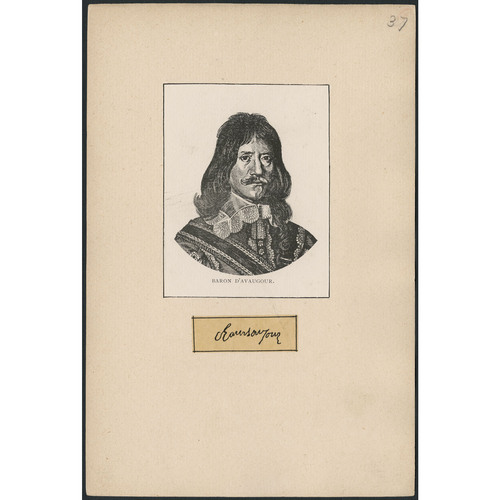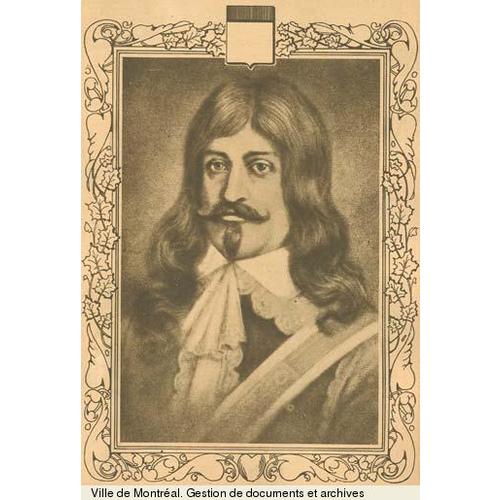
Source: Link
DUBOIS DAVAUGOUR, PIERRE, baron, governor of New France 1661–63 (the last to serve under the jurisdiction of the Compagnie des Cent-Associés); d. fighting against the Turks at Serinvans-Zrin, on the borders of Croatia, 24 July 1664.
Davaugour, whose family could trace descent from a cadet branch of the counts of Brittany, had spent some 40 years in the army prior to his Canadian appointment. This would indicate that he was in his late fifties when he came to Canada. During the Thirty Years’ War in Germany he served with distinction as a colonel in the French cavalry and during the closing stages of the war he was attached to the Swedish forces allied to France. In 1646 he acted as liaison officer for the great French general Turenne with the commander of the Swedish armies in Germany, to co-ordinate joint plans for the ensuing campaigns in the Rhineland against the armies of the Hapsburg Holy Roman Emperor. He subsequently served as Louis XIII’s résident, or agent, in Germany and then was posted to the French armies in Flanders to supervise the implementation of the terms of the Treaty of Westphalia which ended the war between France and her allies on the one side and the emperior on the other. In 1658 he was sent on a diplomatic mission to Sweden, then, in 1661, on the recommendation of the queen he was appointed governor of New France for a three-year term, to succeed Voyer* d’Argenson.
In character he was very forthright, not given to compromise, rather hasty in his judgements at times, and quick to resent the slightest disagreement with his expressed views. He made his decisions very swiftly, sometimes without sufficient reflection, and was very loath to rescind an order, once given, even though the consequences were manifestly undesirable. Colbert, in 1661, commented on “his bizarre and rather untractable character.” These were, however, almost the distinguishing marks of the French soldier and aristocrat of the period.
Yet Davaugour had one outstanding gift: imagination. From the moment of his arrival in New France on 31 Aug. 1661, he grasped the great potentiality of the country and he later wrote: “I believed, as did everyone else, that Canada was a country as savage as it was forsaken . . . and to tell the truth nothing in the world has appeared to me so beautiful as the river St. Lawrence, so pleasing to the eye, so fruitful for commerce, and so advantageous for the establishing of the fleurs de lis. . . .” But before any such vision of future greatness could begin to be realized, the colony had to be relieved of the constant harrying attacks of the Iroquois. Since the days of Champlain the savage warriors of the five Iroquois nations had waged an intermittent war of ambush and surprise attack against the French settlers in an attempt to destroy their hold on the western fur trade. Not only did these attacks inflict heavy casualties on the French, but they prevented the development of the colony’s resources; fields were left idle and cattle could not put out to pasture. Davaugour, with the contempt of the European soldier for irregular warfare, was of the opinion that a few hundred regular troops would quickly quell the Iroquois but he made it plain that the colony could not support the expense of maintaining such a force. In fact, the 100 soldiers he had brought with him from France were too great a burden for the colony to bear and in a letter to the Prince de Condé, dated 13 Oct. 1661, he bluntly stated: “If with the knowledge of this the king do not interpose, and do not send me my bread and that of the hundred soldiers whom I have brought with me, I shall have the honour of saying something more on this subject to your Highness next year, with God’s help. And, in my opinion, I would rather rob the altar than impose upon them a burden they cannot yet bear.” To clarify his views on what should be done he sent Pierre Boucher*, a long-time resident of the colony and governor of Trois-Rivières, to France. The choice of Boucher for this task proved to be an excellent one; he returned the following year with 200 settlers, 100 soldiers, and the assurance of much greater aid in the very near future.
Meanwhile, in addition to informing the members of Louis XIV’s Conseil d’État of what could, and should, be done for the development of Canada, Davaugour was busy with more immediate problems. After visiting all the outlying settlements of the colony he returned to Quebec and appointed to its Conseil the superior of the Jesuits, on the ground that it was they who had done the most for the country. At the same time, he conspicuously failed to invite Bishop Laval* to take a seat at the council table. He did, however, support Bishop Laval, and the Jesuits, in their determined efforts to ban the sale of liquor to the Indians. Their opposition to this commerce stemmed from the fact that the Indians drank only to become intoxicated. They believed that liquor transported them into the strange world of their primitive gods and they themselves became akin to the gods when drunk. But, lacking the inhibitions of Europeans, too many of them lost every vestige of self-control, committed horrible crimes while inebriated, and afterwards disclaimed all responsibility for their actions. So eager were many of them to obtain liquor that they would trade all their furs for a jug or two of brandy. For the more unscrupulous of the French traders this offered an excellent opportunity to make large profits. The clergy, however, were appalled by the effects liquor had on the Indians and in 1660 Bishop Laval had declared that anyone selling liquor to the Indians would be excommunicated ipso facto. The following year, in September, Davaugour strengthened the clerical injunction by issuing an edict forbidding all trade in liquor to the Indians on pain of the severest penalties and to show that he meant it, the following month, two men, convicted of contravening the edict, were shot [see Vuil] and a third flogged in the public square at Quebec. These harsh penalties had a very salutary effect.
Then, in January 1662, a woman of Quebec was caught contravening the edict and sent to prison by order of the governor. Her family and friends pleaded with Father Jérôme Lalemant to intercede on her behalf. This he did, and he apparently irked Davaugour in doing so. The governor, accustomed to the stern discipline of the army, could not abide exceptions being made to his orders. He feared that this would result in a general flouting of the edict and a consequent loss of respect for law and authority in the colony. He brusquely informed Father Lalemant that if it were not a crime for this particular woman to trade brandy to the Indians, then it would not in future be considered a crime for anyone. He accused the Jesuit of inconsistency in wanting to save the woman, while opposed in principle to the brandy trade. Having once said this, he refused to reconsider his decision and immediately issued a new edict which removed the restrictions on the brandy trade.
When tales of the violent excesses once again being committed by the Indians reached the bishop, he renewed his mandamus of excommunication. This meant that the clergy were forbidding what the secular authority had specifically allowed. Relations between Bishop Laval and the Jesuits on the one hand and Davaugour on the other now became very strained indeed. Any who supported the clergy’s stand became aware of the governor’s displeasure. Bishop Laval therefore decided to go to France to plead at the court that some means be found to end the disorders caused by the brandy traffic.
Meanwhile the governor of Montreal, Chomedey de Maisonneuve, issued an edict of his own forbidding the sale of brandy to the Indians, after a citizen of the town had been brutally killed on his own doorstep by a drunken Indian. This action on the part of Maisonneuve annoyed Davaugour and he attempted to undermine Maisonneuve’s authority. He also attempted to impose a 10 per cent duty on goods imported by the seigneurs of Montreal and to impose restrictions on the town’s merchants. When Maisonneuve came to Quebec with Jacques Le Ber*, one of the leading merchants of Montreal, intending to cross to France, Davaugour refused to allow Maisonneuve to leave the colony, had Le Ber arrested and ordered his goods seized on a charge of having fomented sedition in Montreal.
These extravagant and authoritarian actions provided Davaugour’s enemies with ample ammunition to use against him. Letters of complaint from all quarters in the colony crossed on the ships that carried Bishop Laval to France. On 6 Nov. 1662 the Comte d’Estrades, French ambassador to the Court of St James’s wrote to Colbert from London: “I learn with great regret, by a letter from the Bishop of Petraea that M. d’Avaugour is behaving very badly at Quebec and that all the people are extremely dissatisfied with his conduct. The quickest remedy that one can apply to this disorder is to send out a new governor.” (BN, MS, Mélange Colbert, 1l2 bis, f.573) The following year Louis XIV took possession of New France from the Compagnie des Cent-Associés, placing it directly under the Crown to be governed and administered by royal officials. At the same time, despite the strenuous objections of Davaugour’s friends at the court, the decision was made by Colbert and Louis XIV to recall him to France.
It was not, however, until 5 July 1663, that word of this – and that the colony had been taken over by the Crown – reached Quebec. In the meantime Davaugour was drafting a lengthy memorial to the minister on what he thought the Crown should do for its colonies in America. The settlements in Newfoundland, Cape Breton, and on the Gaspé coast were not, he thought, worth bothering much about, but no expense or effort should be spared to establish a strong colony in the St. Lawrence valley. The defences at Quebec, he declared, could be made impregnable by building forts on both sides of the river; 3,000 soldiers would be required for three years to quell the Iroquois, and that done they could remain in the colony as settlers. The establishment of a fort on the Hudson River, with other connecting forts down the Richelieu and Lake Champlain, to open up year-round communications by sea would be an easy matter. These things done, Quebec would become the keystone of ten great provinces stretching into the interior, and these ten would guarantee the security of a hundred others. “When I reflect,” he wrote, “on the object of the wars of Europe for fifty years, and the progress to be made here in ten, my duty not only obliges, but impels, me to speak boldly.” The cost of implementing his great plans he estimated at 400,000 francs a year, for ten years, plus the cost of 3,000 infantry for three years. “I am much mistaken,” he wrote, “if that does not suffice to establish a vast design, and to doubt it I must have forgotten all the idle expenditure that I have seen at divers points.”
At the same time as he was projecting the future expenditure of millions of livres on the colony, Davaugour was having a hard time raising enough revenue to meet the day-to-day expense of his administration. In March 1663, on his own authority he leased the collection of the 25 per cent tax on furs exported from Quebec to a group of 17 residents of the colony for a lump sum of 50,000 livres a year. In addition these tax farmers also received the sole right to trade with the Indians at Tadoussac. Six months later, after Davaugour’s departure, at one of the first meetings of the newly established Conseil Souverain, this contract was declared null and void because it had been executed without any consultation with the old council, duly established to deal with such matters.
Then, on 7 July, the ships arrived from France and Davaugour learned that he was being recalled. This came as a rude shock to him and in his impulsive fashion he made ready to leave the colony immediately, without waiting for his successor to arrive. He appointed his lieutenant, Jacques de Cailhault de La Tesserie, acting governor and sailed from Quebec on 23 July.
On 4 August, he added a few bitter sentences to his memorial on Canada, declaring that he had never expected the charges of his critics would be taken seriously. “When I permitted them to repair to the court,” he wrote, “I in no wise doubted but they would have composed verses in my praise, but the interest of the King’s service, and forty years’ experience under the bravest men that ever commanded, appeared to me a strong protection against such base spirits. To terminate this bickering, I shall content myself, through the respect I owe their cloth, by assuring you, my Lord, that I have served, by God’s grace, not only well and faithfully, but right honestly, according to my means, and that my acts, when better understood, will never excite the King’s wrath, nor that of the Queen Mother.”
In France, Davaugour did not tarry long at the court. He took service with armies of the elector of Mayence then helping to stem the advance of the Turks into Hungary. On 24 July 1664 he was killed, fighting valiantly. at Serinvans-Zrin on the borders of Croatia.
It could not be said that he had been a very successful governor of New France. He was too much the rough, blunt soldier to perform successfully the functions of civil administrator. Nor had he had available adequate military forces to end the constant assaults of the Iroquois on the colony. His projected plans for the future development of Canada were visionary, quite outside the realm of practicality. In his conflicts with the clergy and the authorities at Montreal, his combative nature had made a difficult situation worse. Although he was to some extent sinned against as well as sinning, the decision to recall him was the only practicable one the king and his ministers could have taken. Yet his recall did not of itself solve, or remove, these problems. His immediate successors were to encounter as much difficulty as he had in their relations with the clergy, perhaps because they were men of the same mould as Davaugour; masters of everything but themselves and more suited for army life than colonial administrative posts. It was, in fact, to be a few years yet before a group of well-trained colonial administrators were to emerge under Colbert’s tutelage. Meanwhile, France had to make use of men such as Davaugour, and all things considered, the country could have been worse served.
[JR (Thwaites), XLVI, 149–53 and NYCD (O’Callaghan and Fernow), IX, 13–17, 20–1 contain items of Davaugour’s correspondence and his memorial to Colbert. Faillon, Histoire de la colonie française III, 25, 30–66 gives a detailed account of events in Canada during Davaugour’s administration. Lanctot, Histoire du Canada, I, 317–36. Francis Parkman, in The old regime (25th ed.), 120–30, briefly discusses some of the events of Davaugour’s régime, but with his habitual, very anti-clerical bias. w.j.e.]. On the dispute between the civil authorities and the clergy over the brandy trade, see: André Vachon, “L’eau-de-vie dans la société indienne,” CHA Report 1960, 22–32.
Cite This Article
W. J. Eccles, “DUBOIS DAVAUGOUR, PIERRE,” in Dictionary of Canadian Biography, vol. 1, University of Toronto/Université Laval, 2003–, accessed April 11, 2025, https://www.biographi.ca/en/bio/dubois_davaugour_pierre_1E.html.
The citation above shows the format for footnotes and endnotes according to the Chicago manual of style (16th edition). Information to be used in other citation formats:
| Permalink: | https://www.biographi.ca/en/bio/dubois_davaugour_pierre_1E.html |
| Author of Article: | W. J. Eccles |
| Title of Article: | DUBOIS DAVAUGOUR, PIERRE |
| Publication Name: | Dictionary of Canadian Biography, vol. 1 |
| Publisher: | University of Toronto/Université Laval |
| Year of publication: | 1966 |
| Year of revision: | 1979 |
| Access Date: | April 11, 2025 |




